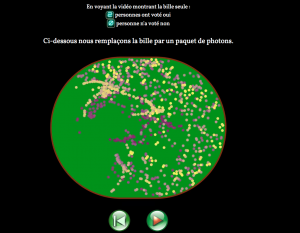Chaotic billiard
| Chaotic billiard | |
|---|---|

| |
| On display at | Fermat Science |
| Type | Digital |
| Topics | Chaos |
Chaotic billiard is a digital exhibit on display at Fermat Science.
Contents
Description
This virtual exhibit explores the understanding that we have about what is the meaning of “chaotic”. Conceived as a quiz/survey, the visitor is shown a simulation of a ball bouncing endlessly on a billiard table with different shapes. For each shape, after seeing the animation, the user must decide if that behavior is chaotic or not. After the user’s choice, the mathematician’s answer is presented, which is not always “yes“ “not“ to be chaotic.
The exhibit is presented on a big touchscreen.
Activities and user interaction
The chaotic behavior is a concept difficult to approach. Every visitor has an idea that “chaotic” means disorder or unpredictable, but it is difficult to identify or measure.
The visitors are attracted by the fact that a billiard table is something real and tangible, not something abstract or big as the world’s weather. Suddenly, understanding a complex mathematical concept is less scary for the visitor. Also, the fact that the exhibit is presented as a quiz, makes it an engaging challenge.
The main screen offers six shapes for a billiard table (stadium, lemon, circle, rectangle, regular pentagon, and rectangle with circular obstacle inside). When we select one of the billiard tables, a first video is presented. In this video, a single ball is bouncing without friction for a few seconds. Then the user is prompted if that is chaotic in his opinion (options are yes, no, pass). Afterward, a second video is presented, this time the ball is substituted by “photons”, or actually, by a bunch of balls that depart from the same point as before, but now their direction spread across a narrow angle (mathematically, a slight perturbation of the initial conditions). In this second video, we can see all the balls bouncing at the same time, with their trajectories diverging slowly. After the second video, the question is repeated to confirm. After confirmation, the mathematical answer is presented. Sometimes the answer is “slightly chaotic”, or other nuances.
Mathematical background
Chaos is a concept in dynamical systems related to the high sensitivity to initial conditions. Even if the system is perfectly determinist (no random effects), the tiniest change in initial conditions (position, speed...) gets quickly amplified and the behavior differs enormously. This is shown successfully in the exhibit by the “photons” simulation since their initial vector speed only differs very slightly. But even with that mathematical concept, it is difficult to say precisely what does it mean to “differ enormously”, so at the end there is always a part of subjective appreciation, which makes it more relevant to have the exhibit in quiz/survey form.
History and museology
The exhibit was conceived by Xavier Buff and Arnaud Chéritat for Fermat Science in 2016. It has been a successful exhibit, with installations sold worldwide (USA, Singapore, the French Antilles amongst others.) Originally, the exhibit was part of a small exhibition about Poincaré, which made contributions to dynamical systems and chaos theory.